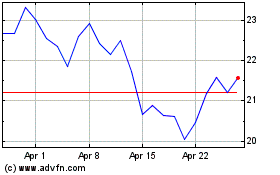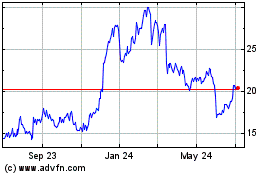Verizon's Unlimited-Data Plan Comes With Caveats
February 14 2017 - 5:59AM
Dow Jones News
By Ryan Knutson
Like its rivals, Verizon Communications Inc. has brought back
unlimited data plans. And like its rivals, "unlimited" comes with a
few caveats.
All four U.S. carriers warn they may temporarily slow
connections for the biggest data users at times of heavy network
congestion. At Verizon, after an unlimited subscriber consumes 22
gigabytes in a billing cycle, the carrier "may prioritize usage
behind other customers in the event of network congestion."
While the average smartphone customer uses less than 5 gigabytes
a month, those who stream lots of video or use their cellphones as
Wi-Fi hot spots can consume far more. Watching an hour of video a
day for a month would require about 10 gigabytes, according to
Verizon's online data calculator.
AT&T says it may take similar action to temporarily throttle
users at 22 gigabytes. For Sprint, the magic number is 23 gigabytes
and at T-Mobile it's 28 gigabytes.
That means that if a bunch of customers are connecting to the
same cell tower at the same time, users who have exceeded those
levels that month will get a slower connection than everyone else
until the congestion passes.
A problem for smartphone owners is that it's hard to know when
or where that might happen. Verizon says: "While we don't expect to
do that very often, network management is a crucial tool that
benefits all Verizon customers."
Another restriction on Verizon's unlimited plan: The company
won't let customers pay for it with a credit card -- debit cards or
checking accounts only. That change is probably saving Verizon 2%
to 3% in credit-card fees, according to analysts at Evercore.
Customers must also choose paperless billing and enroll in autoplay
or else pay $10 more a month.
Verizon had stopped selling unlimited plans in 2011 and
consistently said such plans don't make money. Several analysts who
studied the impact of the unlimited plan, which costs $80 for a
single phone and $180 for four phones, said it would likely be
neutral to the company's average revenue per user.
That's because while the unlimited plan is priced below
Verizon's bigger monthly data plans, the company might encourage
users with smaller plans to pay up for data they don't consume.
Last month, for example it was selling a $55 monthly plan with 5
gigabytes of data.
"By offering unlimited, Verizon is making its slate of offerings
more competitive with peers; however, it is not cheap enough to
have a dramatic impact on share," analysts at New Street Research
wrote in a note to clients.
The unlimited offering could also help the company compete for
customers with Sprint Corp. and T- Mobile US Inc., which have been
pushing lower-priced unlimited plans, as well as AT&T, whose
unlimited plan requires customers to sign up for its DirecTV
satellite service.
Unlike its rivals, Verizon's unlimited service allows users to
stream high-definition videos for no additional charge. Sprint and
T-Mobile only included lower- quality video in their unlimited
plans, which they rolled out last year, unless users paid extra
fees.
On Monday, T-Mobile responded to Verizon's offer by saying that
it too would let customers stream HD video on its unlimited plan
starting Friday. It also dropped the price of two lines with
unlimited data by $20 to $100 a month. Sprint's most recent
promotion is 5 lines with unlimited data for $90 a month.
Verizon's unlimited-data customers can turn their smartphones
into a Wi-Fi hot spot in order to connect laptops, tablets or other
devices. But users will be slowed to 3G speeds after 10 gigabytes
have been consumed in a month.
T-Mobile said Monday it would include a similar amount of data
for hot-spot users on its unlimited plan. Sprint's plan includes 5
gigabytes of such data use, while AT&T doesn't allow it on its
unlimited plan.
Write to Ryan Knutson at ryan.knutson@wsj.com
(END) Dow Jones Newswires
February 14, 2017 05:44 ET (10:44 GMT)
Copyright (c) 2017 Dow Jones & Company, Inc.
SentinelOne (NYSE:S)
Historical Stock Chart
From Mar 2024 to Apr 2024

SentinelOne (NYSE:S)
Historical Stock Chart
From Apr 2023 to Apr 2024
